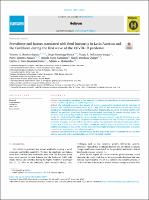| dc.contributor.author | Benites Zapata, Vicente A. | |
| dc.contributor.author | Urrunaga Pastor, Diego | |
| dc.contributor.author | Solorzano Vargas, Mayra L. | |
| dc.contributor.author | Herrera Añazco, Percy | |
| dc.contributor.author | Uyen Cateriano, Angela | |
| dc.contributor.author | Bendezu Quispe, Guido | |
| dc.contributor.author | Toro Huamanchumo, Carlos J. | |
| dc.contributor.author | Hernandez, Adrian V. | |
| dc.date.accessioned | 2023-03-22T18:01:46Z | |
| dc.date.available | 2023-03-22T18:01:46Z | |
| dc.date.issued | 2021-10 | |
| dc.identifier.citation | Heliyon. 2021; 7(10). | es_PE |
| dc.identifier.issn | 2405-8440 | |
| dc.identifier.uri | https://hdl.handle.net/20.500.12959/3495 | |
| dc.description.abstract | Objective: We assessed the prevalence of food insecurity (FI) and its associated factors in Latin American and the Caribbean (LAC) early during the COVID-19 pandemic.
Methods: We performed secondary data analysis of a survey conducted by Facebook and the University of Maryland. We included adults surveyed from April to May 2020. FI was measured by concerns about having enough to eat during the following week. Sociodemographic, mental health, and COVID-19-related variables were collected. We performed generalized Poisson regressions models considering the complex sampling design. We estimated crude and adjusted prevalence ratios with their 95% confidence intervals.
Results: We included 1,324,272 adults; 50.5% were female, 42.9% were under 35 years old, 78.9% lived in a city, and 18.6% had COVID-19 symptoms. The prevalence of food insecurity in LAC was 75.7% (n = 1,016,841), with Venezuela, Nicaragua, and Haiti with 90.8%, 86.7%, and 85.5%, respectively, showing the highest prevalence. Gender, area of residence, presence of COVID-19 symptoms, and fear of getting seriously ill or that a family member gets seriously ill from COVID-19 were associated with a higher prevalence of food insecurity. In contrast, increasing age was associated with a lower prevalence.
Conclusion: The prevalence of food insecurity during the first stage of the COVID-19 pandemic in LAC was high and was associated with sociodemographic and COVID-19-related variables. | es_PE |
| dc.description.abstract | Objetivo: Evaluamos la prevalencia de la inseguridad alimentaria (IF) y sus factores asociados en América Latina y el Caribe (ALC) al principio de la pandemia de COVID-19.
Métodos: Realizamos un análisis de datos secundarios de una encuesta realizada por Facebook y la Universidad de Maryland. Incluimos adultos encuestados de abril a mayo de 2020. La FI se midió por la preocupación por tener suficiente para comer durante la semana siguiente. Se recogieron variables sociodemográficas, de salud mental y relacionadas con la COVID-19. Realizamos modelos de regresión de Poisson generalizados considerando el diseño de muestreo complejo. Se estimaron razones de prevalencia crudas y ajustadas con sus intervalos de confianza al 95%.
Resultados: Incluimos 1.324.272 adultos; El 50,5% eran mujeres, el 42,9% tenían menos de 35 años, el 78,9% vivían en una ciudad y el 18,6% tenían síntomas de COVID-19. La prevalencia de inseguridad alimentaria en ALC fue de 75,7% (n = 1.016.841), siendo Venezuela, Nicaragua y Haití con 90,8%, 86,7% y 85,5%, respectivamente, mostrando la prevalencia más alta. El género, el área de residencia, la presencia de síntomas de COVID-19 y el miedo a enfermarse gravemente o a que un familiar se enferme gravemente de COVID-19 se asociaron con una mayor prevalencia de inseguridad alimentaria. Por el contrario, el aumento de la edad se asoció con una menor prevalencia.
Conclusión: La prevalencia de la inseguridad alimentaria durante la primera etapa de la pandemia de COVID-19 en ALC fue alta y estuvo asociada a variables sociodemográficas y relacionadas con el COVID-19. | es_PE |
| dc.format | application/pdf | es_PE |
| dc.language.iso | eng | es_PE |
| dc.publisher | Cell Press | es_PE |
| dc.relation.uri | https://www.sciencedirect.com/science/article/pii/S2405844021021940 | es_PE |
| dc.rights | info:eu-repo/semantics/openAccess | es_PE |
| dc.rights.uri | https://creativecommons.org/licenses/by-nc-sa/4.0/ | es_PE |
| dc.subject | Food insecurity | es_PE |
| dc.subject | Covid-19 | es_PE |
| dc.subject | SARS-CoV-2 | es_PE |
| dc.subject | Latin America | es_PE |
| dc.subject | Inseguridad alimentaria | es_PE |
| dc.subject | América Latina | es_PE |
| dc.title | Prevalence and factors associated with food insecurity in Latin America and the Caribbean during the first wave of the COVID-19 pandemic | es_PE |
| dc.title.alternative | Prevalencia y factores asociados a la inseguridad alimentaria en América Latina y el Caribe durante la primera ola de la pandemia del COVID-19 | es_PE |
| dc.type | info:eu-repo/semantics/article | es_PE |
| dc.subject.ocde | https://purl.org/pe-repo/ocde/ford#3.03.08 | es_PE |
| dc.subject.ocde | https://purl.org/pe-repo/ocde/ford#3.03.09 | es_PE |
| dc.identifier.doi | https://doi.org/10.1016/j.heliyon.2021.e08091 | |






